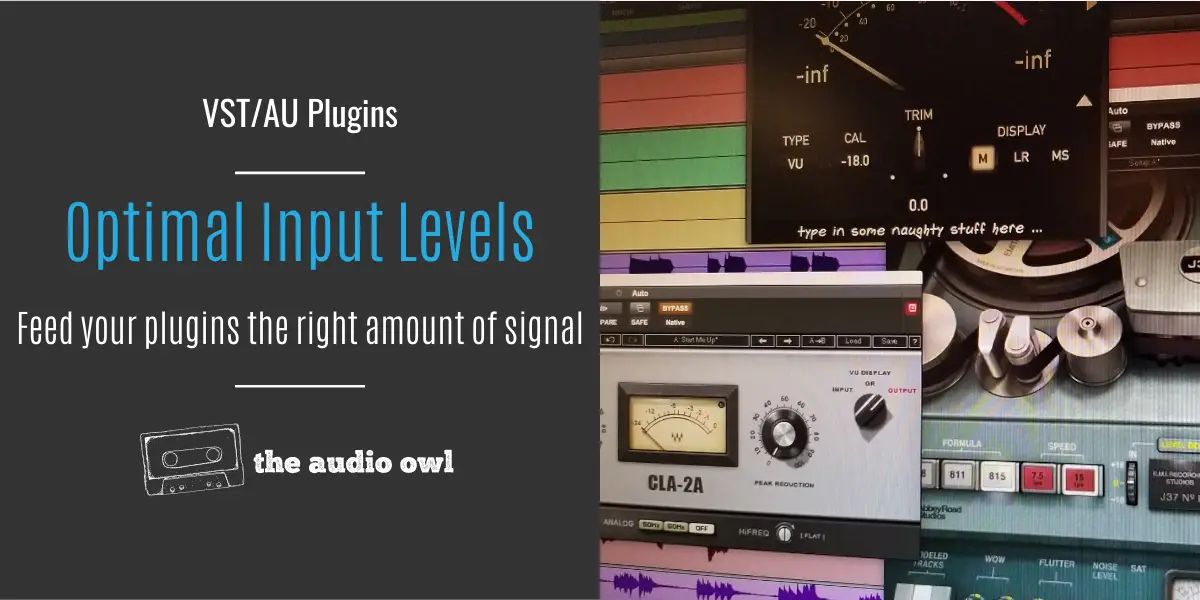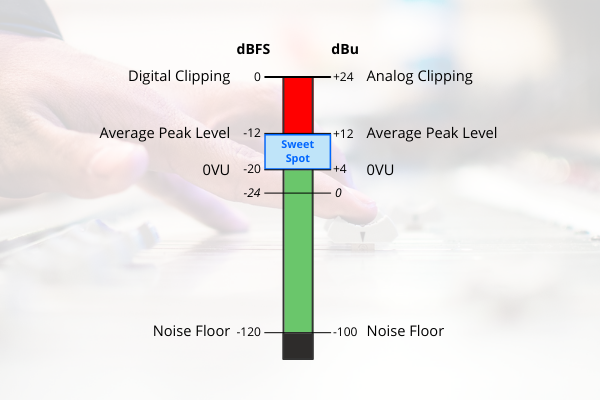Ever wonder if you’re driving the input of your plugins too hot? Are you sending them audio at the correct level? Is there even a correct level to send to your plugins? What are your plugin’s sweet spots?
You’ll want to know the best levels to set when you are gain staging.
You might be surprised to learn that some of your plugins do have a sweet spot when it comes to input levels.
Let’s explore!
Where the Sweet Spot Comes From
The idea of digital sweet spots for audio plugins comes from signal levels in analog hardware.
When working with analog hardware, there are limitations on the unit’s ability to process audio. Hardware units are designed to work at specific levels of input audio.
When a signal is too low, the noise floor of the hardware is louder relative to the amplitude of the input signal. When the signal is too loud we push the hardware unit past its capabilities and introduce clipping.
Metering In VU
The amplitude of an audio signal in the analog world is usually measured in Volume Units (VU).
0VU is equal to -18dBFS or +4dBu.
Looking at the image below we can see how the levels relate to one another. Setting out levels to 0VU leaves us with about 20dBFS or 20dBu of headroom. Levels set here have a low chance of clipping the track.
If you drive the levels hotter you risk clipping the signal. In the analog world, this is fine and often encouraged. But in the digital world, clipping sounds terrible and is not favorable.
Analog-Modelled Plugins
Analog-modeled plugins make use of the 0VU level in the form of -18dBFS.
When plugins are built to emulate analog hardware, they are designed to work with audio levels of 0VU. This translates to around -18dBFS on a digital meter, depending on who you ask. There are many free plugins that can help you compare levels.
Using this level as a reference, designers were able to faithfully recreate the way analog hardware distorts when a louder signal is driven to the input.
Essentially they matched the input levels of the analog world in the digital world.
Where To Find The Sweet Spot Number?
The Plugin Manual
Many, but not all, plugin designers will include a sweet spot reference in their manuals.
For example, the Waves CLA-2A Compressor states the plugin is designed to work with levels at -18dBFS/+4dBu.
Listen For It
Another way to find the sweet spot is to listen for it. When you load a plugin onto a track, listen to what happens when you drive different levels of audio to the input.
Start by turning the volume all the way down. Slowly bring the volume up and listen to how your plugin reacts.
Is there distortion? If the signal is too low, is the plugin gating it?
Doing this can really help you get a “feel” for your plugins too.
Plugins Sweet Spot Reference List
Below we’ll take a look at the sweet spot for some of the most popular plugins. We find these numbers or ranges by reading the manual for the plugin. Some plugin creators will include this information in their manuals.
This is hardly a comprehensive list, just observations we have made so far.
Slate Digital
Virtual Mix Rack Modules
Sweet Spot: -18dBFS
See Manual
Virtual Tape Machines
Sweet Spot: -18dBFS
See Manual
VMS ML-1 + ML-2
Sweet Spot: -12 to -10dBFS
See Manual
UAD
Ampex ATR-102 Tape Machine
Sweet Spot: -12dBFS
See Manual
Neve 33609
Sweet Spot: -14, -18, -22dBFS
See Manual
Studer A800 Tape Machine
Sweet Spot: -12dBFS
See Manual
Teletronix LA2A
Sweet Spot: -12dBFS
See Manual
Waves
Abbey Road TG Mastering Chain
Sweet Spot: -12dBFS
See Manual
*This one was more of a hint to the sweet spot
APHEX VINTAGE AURAL EXCITER
Sweet Spot: -18dBFS
See Manual
CLA-2A Compressor / Limiter
Sweet Spot: -18dBFS
See Manual
CLA-76
Sweet Spot: -18dBFS
See Manual
J37 Tape
Sweet Spot: -3VU to 0VU
See Manual
Kramer HLS Channel
Sweet Spot: -18dBFS
See Manual
KRAMER MASTER TAPE
Sweet Spot: -18dBFS
See Manual
Kramer PIE Compressor
Sweet Spot: -18dBFS
See Manual
SSL 4000 Collection
Sweet Spot: -18dBFS
See Manual
V-Comp
Sweet Spot: -22dBFS to -17dBFS
See Manual
Author: Mike P
Hi! My name is Mike! I’ve been an apartment producer/musician for 10+ years. I’ve played in punk bands, released EDM tunes on Beatport and iTunes, and have a semi-successful stock music portfolio. Read more…




